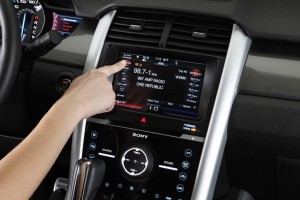Ford Motor Co. wants to function “more like a consumer electronics company,” CEO Alan Mulally has repeatedly stressed, something the maker is backing up with an array of in-car technologies that notably include the popular Sync infotainment system and the latest iteration, MyFordTouch.
The focus on what some call “bleeding edge” technology has paid off in many ways. Mulally, for one, has repeatedly keynoted the Consumer Electronic Show three times, an honor more traditionally granted the likes of a Bill Gates or Steve Jobs. And Ford suggests that Sync has been a major factor in the buying decision for many customers, especially younger motorists who expect to be connected 24/7.
But there’s a downside, as the maker was reminded this week. Ford was pummeled in the latest J.D. Power Initial Quality Study, a closely-followed measure of out-the-factory-door quality. (Click Here for the full report on IQS.) Just a year ago, the maker shot to 5th place, topping rivals like Honda and Toyota to become the highest-ranked mainstream brand. But this year, Ford plunged to 23rd, behind not only the major Japanese brands but long-time quality laggards like Chrysler and its Ram truck brand.
“Ford dropped notably last year,” said Dave Sargent, the head of global research for Power, the California-based market research firm, adding that, “If it weren’t for MyFordTouch, we wouldn’t be talking about Ford.”
The maker’s original Sync system was designed to make it easier for motorists to operate various onboard information and entertainment – or infotainment – systems, including a vehicle’s navigation and audio. The technology has continued to evolve, even permitting a motorist to tap into some of the “apps” on a cellphone, such as the Pandora radio service, which lets you create your own “channels.”
The newest features have been incorporated into MyFordTouch and MyLincolnTouch, sold through the sibling Lincoln luxury brand. On the recently updated Lincoln MKX crossover, for example, most of the traditional knobs and buttons have been eliminated. For the bulk of vehicle operations, Ford has migrated to either voice control, giving drivers the alternative of using a smartphone-like toggle on the steering wheel or the ability to work through menus on the vehicle’s LCD screen.
Unfortunately, despite that redundancy, many motorists appear baffled. And they’re not alone. Consumer Reports, the influential buyer’s guide, earlier this year lifted its recommendation for several of the newest Ford models using the new Touch system.
And the technology was one of the single most frequent sources of complaint filed by Ford and Lincoln owners filling out the lengthy questionnaire for the 2011 Power IQS.
“The design was not as intuitive as some consumers would like,” stressed Power research chief Sargent.
The IQS has frequently fielded its own criticism for the way it measures “problems” with vehicles. A maker like Ford is dinged the same amount for a complaint about Sync as it would be if an owner reported a faulty transmission. But Power officials defend their metrics, insisting that whatever the problem it will impact owner satisfaction – and long-term loyalty.
And that’s where Ford has taken a risk. “They made the decision to be a leader in this area,” knowing technologies like Sync will help drive sales, but longer term, if Ford can’t resolve the problems with its technology, it could be, “in a somewhat vulnerable position.”
Ford isn’t the only maker to discover that. BMW also became the darling of the high-tech set when, nearly a decade ago, it introduced its first-generation iDrive system, which used a computer-like controller to access most vehicle functions, which it migrated onto the video display on products like the 7-Series.
But studies suggest that motorists still like having buttons and knobs for some basic functions, such as volume, temperature and seat-heaters.
“We listen closely to customer feedback, including studies such as this report and our own research,” Ford announced in a release responding to the 2011 Initial Quality Study. “We use the feedback to make continuous improvements and ensure we provide customers the highest-quality vehicles.”
Indeed, at a technology forum at its research labs, this week, Ford’s President of the Americas Mark Fields underscored the effort to get the MyFordTouch and Sync technology right.
It needs to move fast. The maker got a head start due to an exclusivity agreement with Microsoft, which developed the initial Sync technology. But that has been completed and Microsoft is now working with other makers, such as Kia, which is bringing its own version to market. Meanwhile, other makers are looking to catch up fast, from Mercedes-Benz to Toyota, which will launch its app-accessing entune system with the new Prius v hybrid later this year.
Of course, those makers also have to worry that if they don’t get it right, they could experience sharp declines in their own IQS scores.

